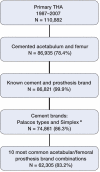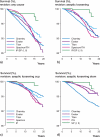18 years of results with cemented primary hip prostheses in the Norwegian Arthroplasty Register: concerns about some newer implants
- PMID: 19857178
- PMCID: PMC2823190
- DOI: 10.3109/17453670903161124
18 years of results with cemented primary hip prostheses in the Norwegian Arthroplasty Register: concerns about some newer implants
Abstract
Background and purpose: Few studies have compared the long-term survival of cemented primary total hip arthroplasties (THAs), and several prostheses have been used without adequate knowledge of their endurance. We studied long-term outcome based on data in the Norwegian Arthroplasty Register.
Patients and methods: The 10 most used prosthesis brands in 62,305 primary Palacos or Simplex cemented THAs reported to the Register from 1987 through 2007 were included. Survival analyses with revision as endpoint (for any cause or for aseptic loosening) were performed using Kaplan-Meier and multiple Cox regression with time-dependent covariates. Revision rate ratios (RRs) were estimated for the follow-up intervals: 0-5, 6-10, and > 10 years.
Results: 5 prosthesis brands (cup/stem combinations) (Charnley, Exeter, Titan, Spectron/ITH, Link IP/Lubinus SP; n = 24,728) were investigated with 0-20 year follow-up (inserted 1987-1997). After 18 years, 11% (95% CI: 10.6-12.1) were revised for any cause and 8.4% (7.7-9.1) for aseptic loosening. Beyond 10 years of follow-up, the Charnley cup had a lower revision rate due to aseptic loosening than Exeter (RR = 1.8) and Spectron (RR = 2.4) cups. For stems, beyond 10 years we did not find statistically significant differences comparing Charnley with Titan, ITH, and SP stems, but the Exeter stem had better results (RR = 05). 10 prosthesis brands (9 cups in combination with 6 stems; n = 37,577) were investigated with 0-10 years of follow-up (inserted from 1998 through 2007). The Charnley cup had a lower revision rate due to aseptic loosening than all cups except the IP. Beyond 5 years follow-up, the Reflection All-Poly cup had a 14 times higher revision rate. For stems, beyond 5 years the Spectron-EF (RR = 6.1) and Titan (RR = 5.5) stems had higher revision rates due to aseptic loosening than Charnley. The analyses also showed a marked improvement in Charnley results between the periods 1987-1997 and 1998-2007.
Interpretation: We observed clinically important differences between cemented prosthesis brands and identified inferior results for previously largely undocumented prostheses, including the commonly used prosthesis combination Reflection All-Poly/ Spectron-EF. The results were, however, satisfactory according to international standards.
Figures






References
-
- Anthony PP, Gie GA, Howie CR, Ling RS. Localised endosteal bone lysis in relation to the femoral components of cemented total hip arthroplasties. J Bone Joint Surg (Br) 1990;72(6):971–9. - PubMed
-
- Arthursson AJ, Furnes O, Espehaug B, Havelin LI, Soreide JA. Validation of data in the Norwegian Arthroplasty Register and the Norwegian Patient Register: 5,134 primary total hip arthroplasties and revisions operated at a single hospital between 1987 and 2003. Acta Orthop. 2005;76(6):823–8. - PubMed
-
- Dall GF, Simpson PM, Breusch SJ. In vitro comparison of Refobacin-Palacos R with Refobacin Bone Cement and Palacos R + G. Acta Orthop. 2007;78(3):404–11. - PubMed
-
- Digas G. New polymer materials in total hip arthroplasty. Evaluation with radiostereometry, bone densitometry, radiography and clinical parameters. Acta Orthop (Suppl 315) 2005;76:3–82. - PubMed
Publication types
MeSH terms
Substances
LinkOut - more resources
Full Text Sources
Medical
